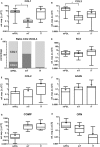Molecular Characteristics of the Equine Periodontal Ligament
- PMID: 29376061
- PMCID: PMC5768624
- DOI: 10.3389/fvets.2017.00235
Molecular Characteristics of the Equine Periodontal Ligament
Abstract
The equine periodontal ligament (PDL) is a fibrous connective tissue that covers the intra-alveolar parts of the tooth and anchors it to the alveolar bone-it, therefore, provides a similar function to a tendinous structure. While several studies have considered the formation and structure of tendons, there is insufficient information particularly on the molecular composition of the PDL. Especially for the equine PDL, there is limited knowledge concerning the expression of genes commonly regarded as typical for tendon tissue. In this study, the gene expression of, e.g., collagen type 1 alpha 1 (COL1), collagen type 3 alpha 1 (COL3), scleraxis (SCX), and fibrocartilage markers was examined in the functional mature equine PDL compared with immature and mature equine tendon tissue. PDL samples were obtained from incisor, premolar, and molar teeth from seven adult horses. Additionally, tendon samples were collected from four adult horses and five foals at different sampling locations. Analyses of gene expression were performed using real-time quantitative polymerase chain reaction (qRT-PCR). Significantly higher expression levels of COL1 and 3 were found in the mature equine PDL in comparison with mature tendon, indicating higher rates of collagen production and turnover in the mature equine PDL. The expression levels of SCX, a specific marker for tenogenic-differentiated cells, were on a similar level in functional mature PDL and in mature tendon tissue. Evidence of chondrogenic metaplasia, often found in tendon entheses or in pressurized regions of tendons, was not found in the mature equine PDL. The obtained results justify further experiments focused on the possible use of equine PDL cells for cell-based regenerative therapies.
Keywords: collagen; equine; periodontal ligament; scleraxis; tendon.
Figures

Similar articles
-
Isolation and characterization of multipotent mesenchymal stromal cells from the gingiva and the periodontal ligament of the horse.BMC Vet Res. 2011 Aug 2;7:42. doi: 10.1186/1746-6148-7-42. BMC Vet Res. 2011. PMID: 21810270 Free PMC article.
-
Finite element analysis of equine incisor teeth. Part 1: determination of the material parameters of the periodontal ligament.Vet J. 2013 Dec;198(3):583-9. doi: 10.1016/j.tvjl.2013.10.009. Epub 2013 Oct 14. Vet J. 2013. PMID: 24220347
-
Scleraxis and osterix antagonistically regulate tensile force-responsive remodeling of the periodontal ligament and alveolar bone.Development. 2015 Feb 15;142(4):787-96. doi: 10.1242/dev.116228. Development. 2015. PMID: 25670797
-
The intricate anatomy of the periodontal ligament and its development: Lessons for periodontal regeneration.J Periodontal Res. 2017 Dec;52(6):965-974. doi: 10.1111/jre.12477. Epub 2017 Jun 21. J Periodontal Res. 2017. PMID: 28635007 Review.
-
Three-dimensional ultrastructural imaging and quantitative analysis of the periodontal ligament.Anat Sci Int. 2020 Jan;95(1):1-11. doi: 10.1007/s12565-019-00502-5. Epub 2019 Sep 10. Anat Sci Int. 2020. PMID: 31506855 Review.
Cited by
-
Trends of regenerative tissue engineering for oral and maxillofacial reconstruction in veterinary medicine.Front Vet Sci. 2024 Feb 21;11:1325559. doi: 10.3389/fvets.2024.1325559. eCollection 2024. Front Vet Sci. 2024. PMID: 38450027 Free PMC article. Review.
-
Biomechanical analysis of occlusal modes on the periodontal ligament while orthodontic force applied.Clin Oral Investig. 2021 Oct;25(10):5661-5670. doi: 10.1007/s00784-021-03868-x. Epub 2021 Mar 4. Clin Oral Investig. 2021. PMID: 33665683
-
Formulation of Hyperelastic Constitutive Model for Human Periodontal Ligament Based on Fiber Volume Fraction.Materials (Basel). 2025 Feb 6;18(3):705. doi: 10.3390/ma18030705. Materials (Basel). 2025. PMID: 39942371 Free PMC article.
References
LinkOut - more resources
Full Text Sources
Other Literature Sources

